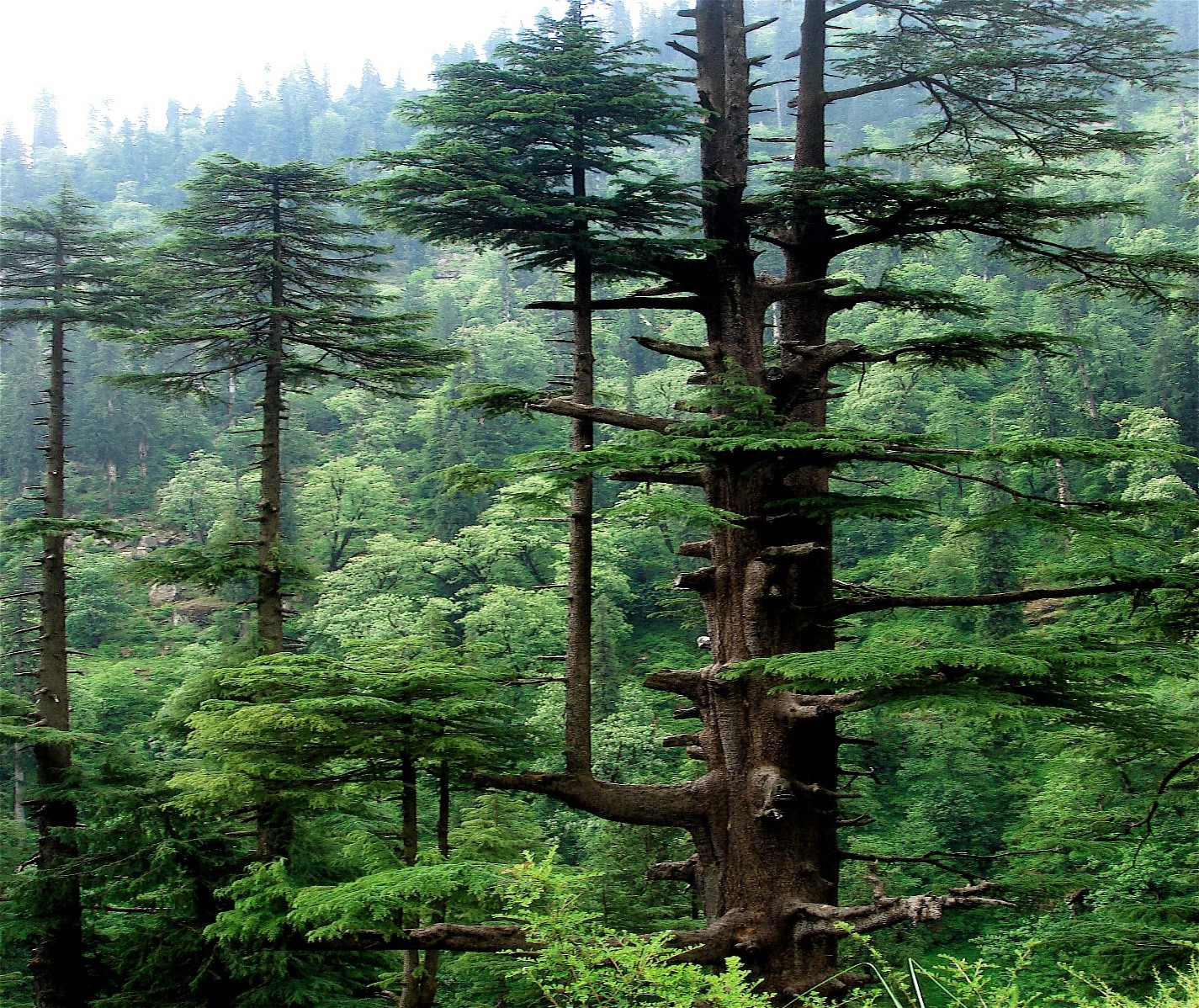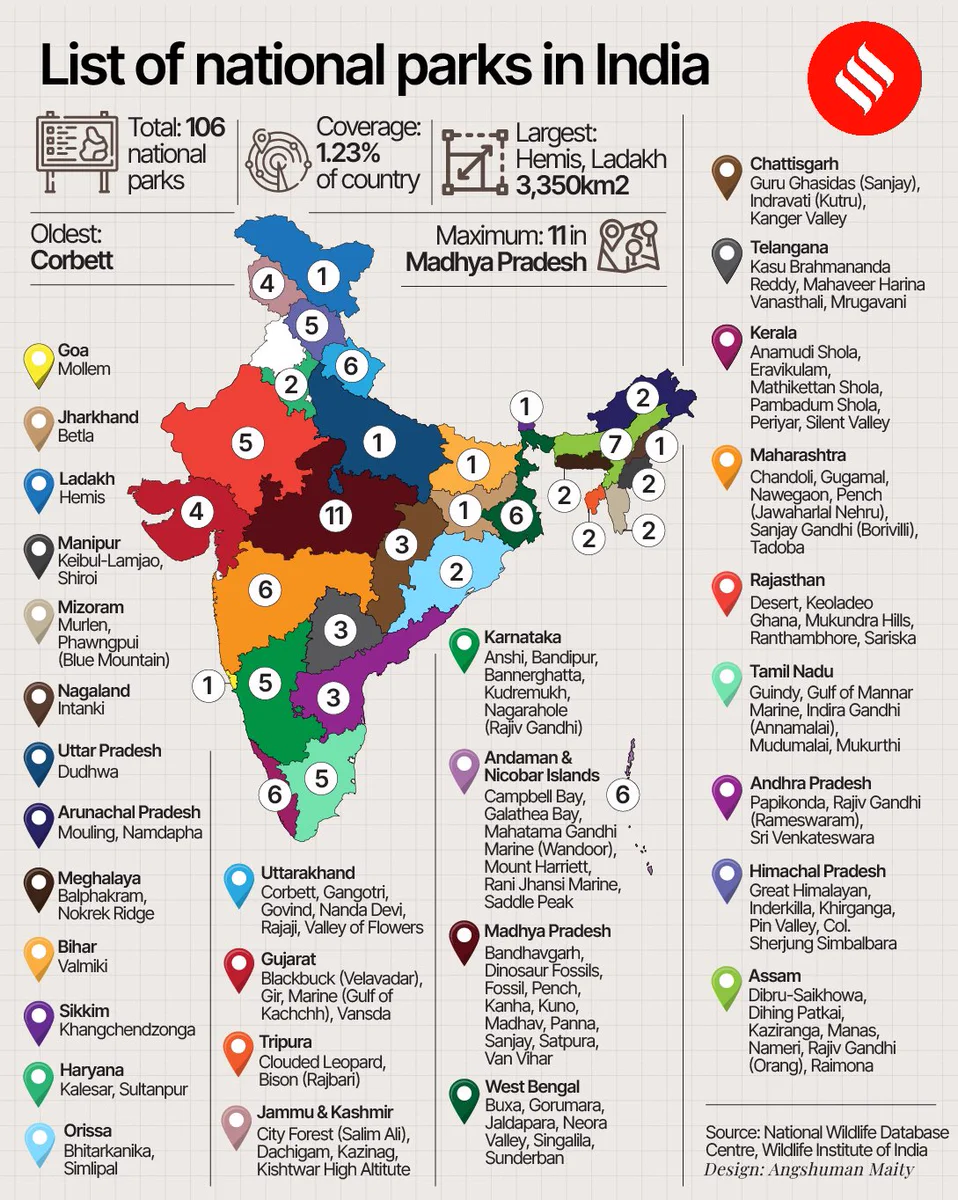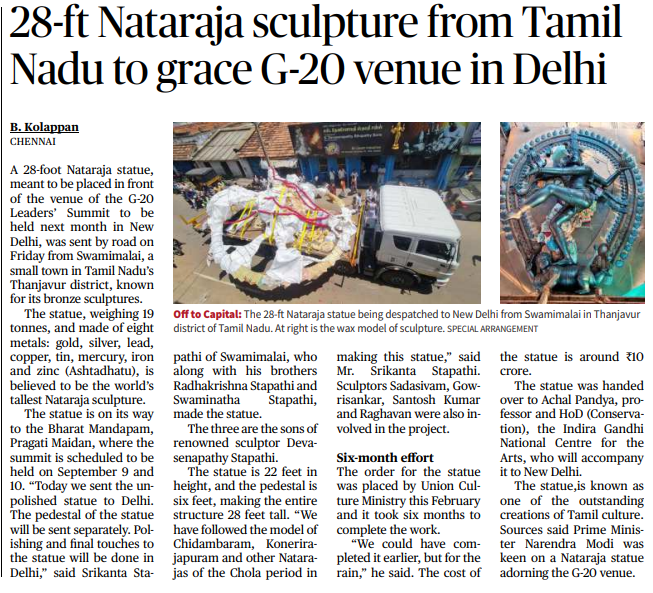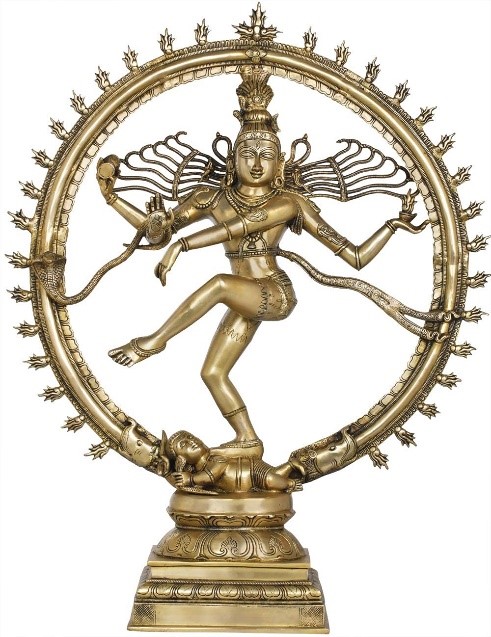Topics
- Global Biodiversity Framework Fund
- Deodar Tree
- Kudremukha National Park
- Lunar Landscape: Near, Far and Dark Side
- Natraj Sculpture
GLOBAL BIODIVERSITY FRAMEWORK FUND
News:
The official ratification and launch of the Global Biodiversity Framework Fund (GBFF) took place at the Seventh Assembly of the Global Environment Facility (GEF) in Vancouver, Canada.
Introduction
- The Global Biodiversity Framework Fund (GBFF) is a new global environmental fund that was launched at the Seventh Assembly of the Global Environment Facility (GEF) on 24 August, 2023 in Vancouver, Canada.
- The GBFF is dedicated to support the implementation of the Kunming-Montreal Global Biodiversity Framework (KMGBF), which aims to put nature on a recovery path by the end of this decade.
- The GBFF will mobilize new and additional resources from various sources, with a special focus on Indigenous-led initiatives for biodiversity protection.
- Small Island Developing States and Least Developed Countries will also receive significant support.
Objectives
The main objectives of the GBFF are:
- To provide an opportunity to receive funding from all sources, quickly disburse through streamlined procedures, with enhanced access for indigenous peoples and local communities, according to their own priorities.
- To provide the opportunity for a greatly enhanced involvement of Multilateral Development Banks and Development Finance Institutes, which will facilitate the mainstreaming of biodiversity necessary to implement the KMGBF.
- To support the achievement of the KMGBF goals and targets, which include reducing threats to biodiversity, ensuring nature’s contributions to people, enhancing implementation through participatory planning and capacity building, and mobilizing sufficient financial resources.
Partnerships
· The GBFF is a partnership between the Convention on Biological Diversity (CBD), the GEF, and other relevant stakeholders.
· The CBD is the main governing body of the KMGBF and provides guidance and oversight for its implementation.
· The GEF is the financial mechanism of the CBD and provides funding and technical assistance for biodiversity-related projects.
· Other stakeholders include governments, civil society organizations, Indigenous peoples and local communities, private sector entities, academic institutions, and international organizations.
· The GBFF will leverage existing partnerships and foster new ones to ensure effective coordination and collaboration for biodiversity conservation and sustainable development.
Contributions
- The GBFF has received initial contributions from the Canadian and British governments of $200 million Canadian and £10 million respectively.
- These contributions are expected to catalyze further investments from other donors and partners.
- The GBFF aims to raise at least $1 billion by 2025 to support the implementation of the KMGBF.
- The GBFF will also seek to align its funding with other relevant initiatives and mechanisms, such as the Green Climate Fund, the Adaptation Fund, and the Global Environment Facility Trust Fund.
Question: Which international initiative aims to address the critical challenges of biodiversity loss and environmental degradation by fostering collaboration, innovative funding mechanisms, and capacity building in the realm of conservation?
- a) Global Green Fund (GGF)
- b) Biodiversity Action Alliance (BAA)
- c) World Conservation Fund (WCF)
d) Global Biodiversity Framework Fund (GBFF)
DEODAR TREE
Context:
A recent study highlighted that climate change and the escalating emissions of greenhouse gases could trigger significant forest losses in the Himalayan Cedar (Cedrus deodara), popularly known as deodar.
Key points:
- Deodar holds substantial market demand due to its prized timber quality, medicinal attributes, and religious significance.
- The ongoing climate crisis is anticipated to lead to a decline of approximately 38 percent in deodar growth within plantations situated in low- and mid-latitude regions.
- Nevertheless, deodar trees in high-latitude sites are projected to experience a moderate growth increase.
Underlying Causes:
- Emission Scenarios:
- Researchers explored potential scenarios for greenhouse gas and aerosol emissions using representative concentration pathways (RCP) 4.5 and 8.5.
- RCP 4.5 outlines a moderate scenario where global emissions peak around 2040 before decreasing, in line with the Intergovernmental Panel on Climate Change’s definitions.
- RCP 8.5 depicts a business-as-usual climate scenario, predicting continuous emissions growth throughout the 21st century.
- Consequently, projections related to the more impactful RCP 8.5 highlight greater repercussions due to climate change.
- Impact of Reduced Distribution and Climate Change:
- Despite its significant carbon sequestration ability, the deodar’s distributional range has contracted due to climate change, human-induced activities like deforestation, and competition with other species.
- Declining deodar growth primarily attributes to elevated temperatures and reduced precipitation during pre-monsoon months, spanning from March to May.
- Threats from Other Species:
- Deodar trees face competition from chir pine species, which exhibit higher drought and fire tolerance.
- At higher altitudes, they contend with silver fir in damp regions and blue pine in arid zones.
- Infestations:
- Insect infestations pose a substantial threat to deodar, resulting in substantial losses.
Further Insights into Deodar Trees:
- Deodar is a large evergreen coniferous tree characterized by its conical crown, horizontal branches, and drooping branchlets.
- Its needle-like leaves range from vivid green to a bluish-green glaucous hue.
- The species is native to regions including East Afghanistan, Southwestern Tibet, Western Nepal, Northern Pakistan, and North-Central India.
- Deodar thrives at altitudes ranging from 1,500 to 3,200 meters.
KUDREMUKH NATIONAL PARK
Context:
Environmental activists in Dakshina Kannada are urging the Forest Department to prohibit access for tourists and trekkers to the unexplored peaks of the Western Ghats within the Kudremukh National Park. This action aims to safeguard the ecologically sensitive Western Ghats.
Key points:
- The Kudremukh National Park is situated in Karnataka, within the Western Ghats.
- This park is among the world’s 38 regions known for exceptionally high biodiversity, designated as ‘hottest hotspots’, and holds the status of a UNESCO World Heritage Site.
- The term “Kudremukha” pertains to both a range of mountains and an individual peak located in the Chikmagaluru district of Karnataka, India.
- The name “Kuduremukha” translates to “horse-faced” in the Kannada language, describing a scenic facet of the mountain resembling a horse’s visage.
- The Kudremukha National Park stands as the second-largest Wildlife Protected Area characterized by tropical wet evergreen forests.
- This region is believed to be the originating source of three significant rivers: the Tunga, the Bhadra, and the Nethravathi.
Kudremukha attained recognition as a National Park in the year 1987.
LUNAR LANDSCAPE: NEAR, FAR AND DARK SIDE
Context
In the realm of lunar exploration, the Chandrayaan-3 mission’s controlled descent of the Vikram lander stood out as a significant milestone, marking an impressive approach to the moon’s South Pole.
Distinguishing the Near and Far Sides of the Moon
- When discussing the moon, it’s important to differentiate between its ‘near side’ and ‘far side’ and debunk the concept of a permanently ‘dark side.’
- The ‘near side’ encompasses around 60% of the moon’s visible surface from Earth.
- This side remains constantly observable due to the synchronous rotation and orbit of the moon.
- However, it’s crucial to note that this doesn’t mean that half of the moon is in continuous darkness.
- The ‘new moon’ phase, when the moon is invisible from Earth, brings sunlight to illuminate the ‘far side’ for approximately two weeks.
- It’s worth clarifying that the term ‘dark side’ can be misleading—historically mysterious, this region’s topography remained concealed until 1959, when the Soviet spacecraft Luna 3 captured images of it.
Contrasting Features: Near Side vs. Far Side
- Discernible differences exist between the moon’s two sides, with notable variances in surface characteristics and features.
- The ‘near side’ boasts a smoother terrain and a higher prevalence of ‘maria,’ extensive volcanic plains.
- Conversely, the ‘far side’ displays vast craters, some spanning thousands of kilometers, believed to be the result of asteroid impacts.
- This dissimilarity stems from the ‘near side’s’ thinner crust, enabling volcanic lava to flow and fill craters, forming flat plains.
- These relatively even plains offer an advantageous setting for space missions, facilitating smoother landings and rover mobility.
The Significance of Chandrayaan-3’s Lunar Landing
- The Chandrayaan-3 mission holds particular significance due to its meticulous selection of a landing area featuring 150-meter gaps, ideal for ensuring a secure descent.
- Remarkably, China’s Chang’e-4 lander stands as the sole successful mission to have touched down on the moon’s far side.
- Chandrayaan-3’s accomplishment lies in its ability to position Vikram, its lander, closer to the lunar South Pole than ever previously achieved, all while remaining within the ‘near side’ boundary.
- Notably, a landing on the moon’s far side would entail a lack of direct line-of-sight communication with Earth, impeding timely updates.
In such a scenario, a relay communication system becomes essential, enabling seamless transmission between the rover and Earth.
NATRAJ SCULPTURE
Nataraja sculpture
- Nataraja is a Sanskrit term that means “Lord of Dance”.
- It is a depiction of the God Shiva as the cosmic dancer who performs his divine dance to destroy a weary universe and make preparations for the god Brahma to start the process of creation.
- Nataraja is one of the most iconic and widely recognized symbols of Indian culture and art.
Origin and history
- The Nataraja sculpture originated in South India under the patronage of the Chola dynasty in the 10th-12th centuries CE.
- The Cholas were great patrons of art and architecture, and they developed a distinctive style of bronze casting that produced masterpieces of religious sculpture.
- The Chola bronzes are considered to be among the finest examples of Indian metalwork, and they reflect the high level of technical skill and artistic sophistication of their makers.
- The Nataraja sculpture was inspired by the ancient Tamil hymns of the Shaiva saints, who described Shiva’s dance as a cosmic act of creation, preservation, and destruction.
- The sculpture also incorporates elements from various Hindu scriptures, such as the Puranas, the Agamas, and the Upanishads, that elaborate on the symbolism and significance of Shiva’s dance.
Features and symbolism
- The Nataraja sculpture depicts Shiva dancing in a ring of fire, called prabha or aureole, that represents the cosmic cycle of creation and destruction.
- He has four arms, each holding or performing a different function.
- His upper right hand holds a small drum, called damaru, that symbolizes the sound of creation.
- His upper left hand holds a flame, called agni, that symbolizes the fire of destruction.
- His lower right hand is in abhaya mudra, a gesture of assurance and protection.
- His lower left hand points to his raised left foot, which symbolizes liberation from the cycle of birth and death.
- Shiva’s right foot is planted on a dwarf, called Apasmara, who represents ignorance and illusion.
- By crushing Apasmara, Shiva asserts his supremacy over ignorance and evil.
- His hair is flying in wild curls, indicating his dynamic energy and movement.
- His face is calm and serene, showing his detachment from the worldly affairs.
- He wears a garland of skulls, representing the past lives of his devotees.
- He also wears ornaments such as earrings, necklaces, bracelets, anklets, and a snake coiled around his neck.
- The Nataraja sculpture is not only a representation of Shiva’s dance, but also a metaphor for the cosmic dance of life itself.
- It conveys the message that life is a dynamic and rhythmic process that involves creation and destruction, order and chaos, harmony and discord.
- It also suggests that one can achieve liberation from suffering by transcending ignorance and illusion, and by realizing one’s true nature as part of the divine.
Examples and locations
- The Nataraja sculpture at Brihadisvara Temple in Thanjavur, Tamil Nadu. It is one of the largest Nataraja sculptures in India, measuring about 3.7 meters in height. It was commissioned by Raja Raja Chola I in the 11th century CE.
- The Nataraja sculpture at Chidambaram Temple in Chidambaram, Tamil Nadu. It is one of the most revered Nataraja sculptures in India, as it is believed to be installed by Shiva himself in his own abode. It is also known as Ananda Tandava or Blissful Dance.
- The Nataraja sculpture at Konerirajapuram Temple in Kumbakonam, Tamil Nadu. It is one of the most graceful Nataraja sculptures in India, with delicate features and proportions. It dates back to the 10th century CE.
- The Nataraja sculpture at National Museum in New Delhi. It is one of the most famous Nataraja sculptures in India, as it was gifted by India to CERN, the European Organization for Nuclear Research, in 2004. It stands at the entrance of CERN’s headquarters in Geneva, Switzerland.
The Nataraja sculpture at Metropolitan Museum of Art in New York City. It is one of the finest examples of Chola bronze art in America. It dates back to the 11th-12th centuries CE.






